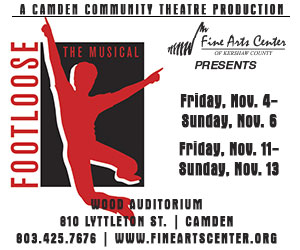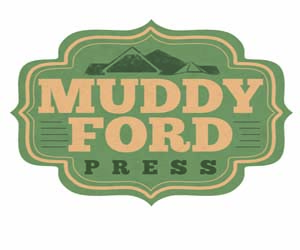A History of Storms: An Interview With James McTeer
 By Susan Tekulve
By Susan Tekulve
James McTeer grew up in the shadow of legendary storms. A native of Beaufort, South Carolina, he was six when Hurricane Hugo hit, and ten when the Storm of the Century blew through. He grew up deep in the balmy South, where winds could peel the roof off his family’s house in September, and it sometimes snowed in March. He grew up among a swirling mix of Lowcountry culture—Southern culture, Gullah culture, military culture. He grew up breathing pungent salt air and river breezes, bogging the muddy marshlands and barrier beaches, sometimes alone, often with his family. Perhaps this is why his debut novel, Minnow, (forthcoming with Hub City Press in May 2015), is a perfect storm of a novel, its protagonist and plot shaped by the exotic beauty and danger inherent in McTeer’s native landscape. Set in the imaginary coastal town of Newfort, Minnow is a quest novel and coming-of-age tale about a boy named Minnow who must journey into the interior of the ancient Sea Islands to find a mysterious medicine to cure his ailing father. What begins as a simple journey becomes a complex meditation upon family loyalty, struggle, solitude, and loss as the boy finds physical and emotional strength to carry on through a series of overwhelming storms, both meteorological and mythological, in order to complete his task.
Heralded as “A gorgeous fever dream of a novel” by Ben Fountain, and as “stark and wild as the fairy tale deep in its bones” by Lauren Groff, this novel delivers a tale that is both mystical and earthy, grounded in the history and culture of the South Carolina Lowcountry, a place where illusion and reality mix naturally, and often look the same. Here, the fishermen hook their boats to manta rays and race each other, and terrifying storms are stirred up by a witchdoctor who’s been dead and buried beneath an ancient live oak for decades. The place details in Minnow are as heady and pungent as the now-famous Lowcountry boil that originated on one of the sea islands that inspired McTeer as he culled details from this very real place to create his fictional setting. The book’s fabulist tone and lyrical language are reminiscent of the stories by William Faulkner or Gabriel Garcia Marquez. To quote the narrator of One Hundred Years of Solitude, McTeer has spun a seamless tale that is, “an intricate stew of truth and mirages.”
Raised in Beaufort, South Carolina, James earned a Bachelor in Arts in English at the University of South Carolina Beaufort and a Masters in Library and Information Science from the University of South Carolina. He now lives in Columbia, South Carolina, where he works as the School Media Specialist at Polo Road Elementary.
ST: I have read that your grandfather, J.E. McTeer, was the High Sheriff of the Lowcountry for 37 years and a local witch doctor, and that he was the inspiration for Minnow. What story, or stories, about him served as the “germ” for this novel?
JM: The core of Minnow’s journey is unique, entirely imagined, but every step of his journey is informed by my grandfather’s legend, and by the stories of his life: the culture of the islands, the politics of witchdoctors, the natural world of the Lowcountry, the voodoo. He embraced the Lowcountry. He loved it. That passion for the Lowcountry is a family tradition. It’s something we celebrate, and I wanted to capture that tradition on the page. So it wasn’t a single story, but many, that make the foundation of Minnow. I found some specific inspiration in his memoirs, of course: little anecdotes, unique images. There is one story in particular, about an encounter with a dog, which I can’t say too much about without giving a lot away.
ST: Family stories make great source material for fiction, but I’ve learned from personal experience that it takes a lot of time to grapple with this material in order to make narrative sense out of it, and to shape it into a novel. What were some of the steps you took in order to shape your “true” family stories into literary fiction? Were there any specific challenges you faced as you went through this process?
JM: Although Minnow springs from a history I would not know without knowing my grandfather’s legacy, the story is separate from our family’s past. I’m lucky in that I could use the rich magic of Grandad’s legend without directly addressing his life. Baynard Woods put down probably the best nonfiction account of Grandad’s life in his book, Coffin Point. That’s been done. I think one day, way down the line, I’d like to try my hand at fictionalizing J. E. McTeer’s story into one plot, one narrative, one novel. But that’s just a notion right now. I’d like to reconsider this question if I ever undertake that endeavor!
ST: Your sense of place is one of the most striking elements of this book. Your setting details are extremely lush, and your sentences are beautiful. Minnow doesn’t just live in this setting; it’s as if he has sprung from the marshes and coastlines he navigates throughout the book. How did you capture the native intelligence of this boy as you were creating him and his journey through the barrier islands?
JM: I grew up in Beaufort, and like any Lowcountry kid, I experienced a unique geography that I don’t think you can find anywhere else in the world. The land gets in your blood, and when you close your eyes you can just see it. I called on places from my entire life to create Minnow: the pine forests out in the Grays Hill country, Hunting Island’s barrier beach, the old homes and cemeteries downtown, the marshes that surround, the creeks that intertwine.
I wanted Newfort to be Beaufort, of course, and some of it is very direct. Bay Street, Frogmore, Port Royal, the Island. These are all real places, but I made them my own for the story. The cemetery near the end of the book is St. Helena’s Episcopal, from downtown, but I moved it out to the islands. Frogmore’s farther out, in real life, but I wanted it on the first island, so there it is. Minnow goes to Coffin Point, which I’ve always called “Coffin’s Point.” There’s an avenue of oaks there, and a plantation house. But you won’t find rice fields. Little things separate Minnow’s world from the real world. Just like in a dream.
I was particularly intentional in “researching” Minnow’s adventures in the coastal marshes. By research, I mean taking long summer walks along the marsh edge of Pigeon Point. I bogged the mud with Minnow tumbling around in my brain. I bogged with my nephews, really trying to remember that magic feeling of exploration you have as a child. That sense of the vast wilderness you can find just around the corner, even if you’re still in town. That wild feeling of the marshland, even if there’s a traffic intersection up on the bluff. I owe a lot to those walks.
ST: This novel is, at heart, both a quest novel and a coming-of-age tale. For me, “the big storm” is one of the most powerful moments that Minnow must reckon with in order to complete his journey AND to grow up. Having lived and taught in South Carolina for over half my life, I’ve met a lot of students from the Lowcountry coastal areas for whom a storm, usually a hurricane, has been their coming-of-age story. In short, there seems to be a history of storms particular to this region you write about. The people who grow up here are forever marked by storms, and, in a way, these storms often shape their most powerful, earliest stories. Was there ever a storm in your childhood that made a lasting emotional impact on you as a person and as a writer?
JM: I grew up knowing what a hurricane was, what a hurricane can do. I grew up tracking storms each hurricane season, so the shadow was always hanging over us. Hugo was my big childhood hurricane, hitting when I was six years old. It ran us out of Beaufort. I remember going to Columbia, and talking to folks we knew in the hotel. If it flooded, they’d come upstairs, and if the roof blew off, we’d go downstairs. It was a tongue-in-cheek agreement, looking back, but scary for a kid to hear. Beaufort got spared the worst of it, but we came home to toppled trees around our neighborhood, and power lines down in the streets.
I got caught up in the 1993 Storm of the Century, when I was ten. We were camping on Hunting Island when it blew in. We camped out there all the time, in good weather and bad, and we tried to ride out that storm, too. It was March, in South Carolina, and it snowed. The tent blew away. Dad had to drive us out around fallen trees, past power lines swinging across the Harbor Island Bridge. We crossed the bridge, and the radio announcer reported that the bridge had closed. I think we were the last people to get out, that day.
So I grew up with that unsettled coastal weather, year round. You never know what’s going to blow in off the ocean.
ST: I have noticed that a few of your early readers have called your setting “dreamlike,” and I agree that the book has an “otherworldly” quality, especially when Minnow reaches the interior island and meets Grayeyes, the witch doctor. At the same time, I have read about the Gullah. These are real people who still live on the islands and have retained their own culture, religious practices, and a language that thrives today. How did you learn so much about the Gullah, the inner workings of their villages, their economic and environmental struggles, and how they might react to a little boy—a stranger—who shows up in their midst?
JM: Growing up in Beaufort means growing up in a swirling mix of cultures. Southern culture, Gullah culture, culture informed by the occupation of Beaufort by the Union, culture flavored by the military bases in town. Exploring the Gullah world was natural for me, having seen its legacy firsthand, having studied it throughout my life. Not many places have such a mix of cultures, even in a country as diverse as America.
The way Minnow interacts with the Gullah in the story was my attempt to shed light on the mixing of those cultures. There are differences between us, wide divides of culture and language and customs, but we find ways to bridge those divides. Outsiders are welcomed in, nurtured, cared for, sometimes under the strangest circumstances. Cultural boundaries are broken down when we aren’t dealing with groups, but with individuals. I also wanted to explore the way that we can understand people based on how they interact with children. If Minnow had been a grown man, the story would have been much different. What sort of person takes advantage of a child, what sort of person is ambivalent, and what sort of person aids them unconditionally? We can learn a lot about people, and our culture, by asking those questions.
ST: Your book reminds me a little of the work of Gabriel Garcia Marquez, or Louise Erdrich. They are both poetic novelists from cultures more closely aligned with religious oddities and the natural and strange world. Do you see yourself in line with these writers? More specifically, what strategies did you use to weave your knowledge of the real, yet relatively unknown, “otherworldly” Gullah culture so seamlessly into your narrative?
JM: Both Marquez and Erdrich tapped their culture, their history. That’s definitely something I wanted to do. Faulkner did it too, trying to describe his “postage stamp of native soil.” But even more, I wanted to examine the history and culture of the Lowcountry through a dreamlike lens. That dreamlike approach is natural, I think, when writing about the Lowcountry. The land is steeped in ghosts, magic, hauntings, voodoo, religion… all of these mystical, bizarre elements. I like fairy tales. I like fantasy. So there’s history, and there’s real geography, but none of it was meant to be historical fiction. None of it was meant to correlate directly with history. It is an impression, a fantastic dream of the Lowcountry. I think you get a special feel for the place, in the end, by taking that approach.
ST: Who are some of your favorite writers? Whose work do you study as you hone your own writing?
JM: I owe a lot to all the great southern writers, but my top three are William Faulkner, Flannery O’Connor, and Cormac McCarthy. I admire their raw fiction. The grittiness, the grotesque, and the bizarre. I love Kurt Vonnegut for his deadpan defamiliarization, James Joyce for his humor and complexity, and Ernest Hemingway for his Spartan prose. Minnow was greatly influenced by fantasy, and horror, and that comes from reading J. R. R. Tolkien, Stephen King, and George R. R. Martin.
Jasper invites you to celebrate the launch of Minnow by James McTeer from 5:30 until 7:30 on Thursday, April 30th at Tapp´s Arts Center.






.jpg)
